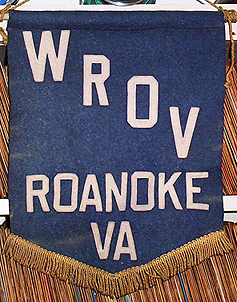
| This 1950s WROV remote banner now hangs in the library of your favorite uncle. |
Heading into the 1950s, Roanoke did not yet have its own television station. With a good antenna, the few who owned TV sets could watch the programming of WFMY-TV from Greensboro, WSAZ from Huntington or WTVR from Richmond.
Radio sounded like an audio version of what television was to become: a diverse selection of music, news, and entertainment programs that typically were thirty or sixty minutes long and changed on the hour. About half were from the network and the rest were done live from the studio or nearby theaters and auditoriums.

| This 1950s WROV remote banner now hangs in the library of your favorite uncle. |
Lee Garrett recalls those days at WROV: "We did everything. We had a format that you wouldn't believe. One hour I might be doing the morning sign on, a thing they called the Yawn Patrol. Then somebody else would come in and pull a couple of records and do something else then next thing I might be doing a country music show, I may be doing a symphony two hours later. You know, we just ran the scale."
WROV's studios in the Mountain Trust Bank building were built with this sort of programming in mind. No expense was spared in making the facility as fine as those of America's larger stations in terms of acoustical quality, efficiency and comfort.
The lobby was furnished in ultra-modern red leather furniture. From there, one could view the entire station operation through glass panels. At the left was the news department with the teletypes arranged so that visitors could read the incoming news and watch the news staff as they prepared material.
Just beyond that was an audition room where one could listen to a performance in complete comfort. Farther back through a long corridor one found the offices. The studio walls featured wainscoting that was painted cascade green and the upper parts were finished in copper, which gave an unusual and pleasing color scheme and went well with the paneling in the main lobby.
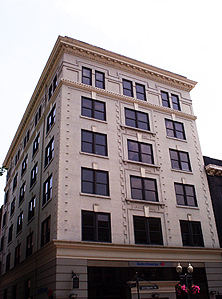
| The former Mountain Trust Bank building, today, is home of the Bank Of America. |
One staffer, known for his pranks, was Coleman Austin. Lee recalls "Coleman would do crazy things. "I was doing a five minute newscast everyday and—like most people do—would go to the men's room before I did that. And I had looked over all the news copy and over the commercial that was in it and I went to the men's room and I got back and in the announce booth and I was sitting there waiting for the system cue. It finally came up and Coleman identified the station and said 'Now here's Lee Garrett with the latest news.'
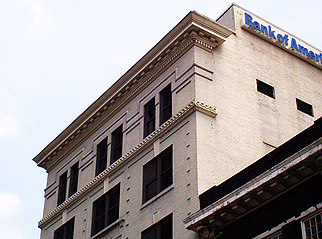
| Another shot of the former MTB building showing the top floor, once the home of WROV, WROV-TV and later WDBJ-TV. |
"I picked it up and I read the first page and pulled it off and the rest of the copy must have had 500 staples in it. It was stapled all together. He let me sit there and sweat for about 30 seconds then he finally brought me some more copy. He did some crazy stuff.
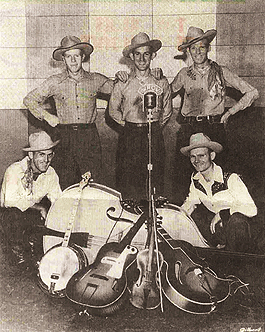
| The Wanderers of the Wasteland were a local act who did a live show on WROV during the station's early days. |
"And we did a remote show up at the old Grand Piano store right across from City Hall at the time. We did about a four hour show every Saturday. And we opened that thing up and I'm sitting there saying—oh you know we went through this long prepared opening, it was a great opening and at the very end they say 'and now here is….'
"And they'd leave it open and I'd come on there and say 'This is Coleman Austin & Lee Garrett… welcome to the show' and about the time I'd get my mouth open, he slapped a piece of tape on it. And I'm sitting there saying “Well folks, mmpph humph mmpph!” And I'd be sitting there reading a commercial and he comes up with a cigarette lighter and sets it on fire. He was crazy!"
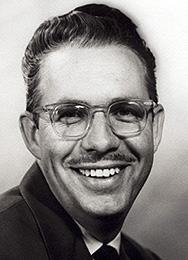
| Jim Shell worked for WROV before moving to Channel 10. |
Following the death of PD Gordon Phillips in a New York City car accident in 1947, Lee and Jim began programming the station and did so for the next six years. The two briefly hosted a live stage show called The Blue Ridge Jamboree that featured acts such as Grandpa Jones and the Carver Sisters. Jim followed Lee to WSLS-TV in 1954.
Lee recalls "we used to have a lot of fun. Tech would have a band coming in on a Friday night, one of the major bands, you know, the Dorsey's for example, they'd play over at Tech and since they were in the area, we would get them into town, take them over to the old Legion Auditorium and put ‘em on the air. I think the only major orchestra that we didn't do was Sammy Kaye because he was on NBC.
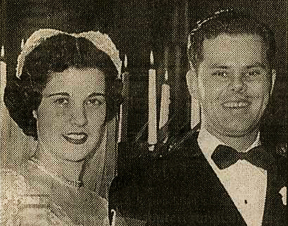
| Lee Garrett married Charlotte, left WROV and joined Channel 10 in 1953. |
In 1954, WROV hired a man who would be with them for the next ten years and a Roanoke radio star for the next twenty-nine. Jerry Joynes, who had worked in Baltimore, Hampton and most recently at WNOR, Norfolk, was one of the last people hired by Roanoke Radio, Incorporated.
Jerry's very first assignment at WROV was to do a live broadcast from the 1954 Miss Virginia Pageant where he luckily ran into an old friend. "You know what my first assignment was when I came to WROV? A beauty pageant. In the Hotel Roanoke. The Miss Virginia pageant. On radio. And I was on the air FOREVER. I mean, these things take a long time. It was 'well, she's walking onto the stage now...'
"Well, it so happened that the runner-up Miss America the previous year, Anne Lee Ceglis, was from Norfolk and I knew her. And she spotted me when I came in and when I saw her I said 'Hold it! You've got to help me out here. I have no idea...' and she did. She sat with me the whole evening and that got me through it."

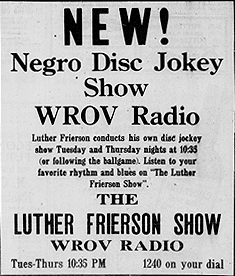
|
Luther Frierson, Roanoke's first black DJ, was first heard on WROV in 1953 The ad appeared in The Tribune, Roanoke's African American Newspaper Hard to believe that in the 1950s, this sort of advertising was common in the south! |
It was in May, 1953 that WROV began heavily promoting The Luther Frierson Show. There had previously been black performers and preachers on Roanoke radio but this was the first time there was a local show devoted to “spinning platters” accompanied by knowledgeable patter from an African American. The Roanoke Times said, “Luther specializes in the three Bs...Blues, Boogie and Bop.” By June he was being publicized as “Roanoke’s only Negro disc jockey.”
The station celebrated the novelty of having a black radio announcer. On July 25, 1953 The Tribune, Roanoke’s African American newspaper, featured a large front page photo of Frierson seated at the WROV radio turntable, the copy underneath gave the additional information that he was a member of Fifth Avenue Presbyterian Church and that he was being “sponsored on several programs by some of Roanoke’s leading stores.”
WROV took out large ads in The Tribune proclaiming “NEW! Negro Disc Jockey Show, WROV Radio.” Well if you look closely you'll see it actually said "Disc Jokey", obviously a typo as "jockey" is correctly spelled later in the ad. Or maybe that was slipped in by some clever copy writer because Luther was a humorous, funny guy? We'll probably never know.
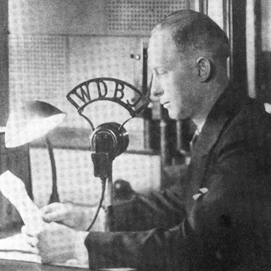
| Hayden Huddleston, shown here during his WDBJ years. |
Another person heard on WROV in the late 1940s and early 1950s was Hayden Huddleston. Hayden helped put Roanoke's first radio station ( 3B1Y , which became WDBJ) on the air while working as a high school student for the Richardson-Wayland Electric company in 1924. He remained with WDBJ for years, then produced radio shows and in the 1950s, started his own agency. For a brief while he was a salesman for WROV.
In 1951 WROV aired another show called "Kommunity Kwiz" which we also suspect was produced by and featured Hayden Huddleston. The show followed the same "K" naming scheme as "Klub Kwiz" and "Klassroom Kwiz" which were Hayden's locally produced television quiz shows that were popular during the 1960s.

| Coleman Austin (left) was an original WROV announcer. He was also seen on the short-lived WROV-TV 27 doing shows such as Teen Talk. |
During the early 1950s, Roanokers joined the TV revolution. In allocating channels for the area, the FCC approved 7, 10, and 27 for Roanoke and 13 for Lynchburg. According to the WDBJ-TV web site, various interests began competing for the channels around 1950. Times World Corporation, which operated WDBJ AM/FM, applied for Channel 7, as did the Polan Brothers of Huntington. Shenandoah Life Insurance Company, owner of WSLS AM/FM, applied for Channel 10. Roanoke Radio, the owners of WROV, applied for and got Channel 27. Lynchburg Broadcasting applied for and got Channel 13.
WSLS-TV went on the air on December 11, 1952, and was joined a few days later by WROV-TV, Channel 27. WLVA signed on in Lynchburg two months later on February 8, 1953. But a few months later the station went "belly up."
Why? One reason is that there weren't that many people in Roanoke who had television sets back then, and to make matters worse, early model TVs weren't able to receive UHF channels without the addition of special equipment.
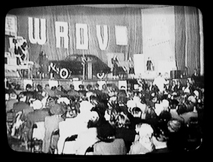
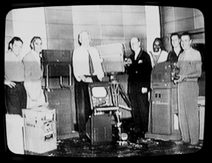
| Scenes from the brief life of WROV-TV: A contest (Lee thinks this was at the old American Theater); some of the staff (the two guys in the middle are Frank Koehler and Hayden Huddleston). |
This wasn't the station's only problem. The studio wasn't lighted well, they only had one camera, and the station had trouble getting programs and sponsors.
According to Lee, "we couldn't get the sponsors because we didn't have the programs and we couldn't get the programs because we didn't have the sponsors. A Catch 22." So, after operating only a few months, WROV-TV became the first UHF station in the country to go dark in 1953.
Then the owners began an effort to acquire the other VHF frequency assigned to Roanoke, Channel 7. According to WDBJ-TV site, "Times World and Radio Roanoke continued competition for the Channel 7 allocation. Times World president J. P. Fishburn led a team of WDBJ and newspaper managers who spent countless weeks and months in Washington in pursuit of the authority to build the new station.
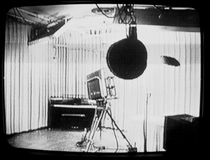
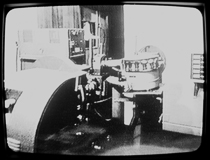
| The WROV-TV Studio showing the station's one camera; some of the equipment that was eventually sold to WDBJ-TV. |
Tragedy struck when Mr. Fishburn suffered a stroke in the course of an FCC hearing and subsequently died. Hearings were recessed for a time, and when they resumed TW and WROV reached an agreement: WROV would drop its application if it recovered its expenses and if TW bought the facilities which had been used for failed Channel 27."
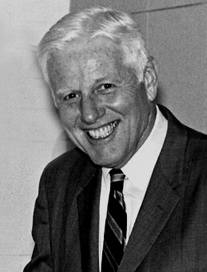
| Frank E. Koehler was WROV GM from 1946 to 1955 then managed WDBJ. He previously managed WSLS radio. |
The advent of television in the early 1950s meant a declining audience for radio stations who were losing their stars to the exciting world of television. Devoid of their personalities, they were now carrying mostly block network programs. Most believed they'd be forever lost in TV's wake. This was happening nationwide, as well as in Roanoke where WROV's failure to acquire a viable television station led to Jim Shell and Lee Garrett leaving for WSLS-TV.
This worried the stockholders of Roanoke Radio, Inc. When it was clear that they would not be going into the television business they appear to have made the decision to get out of broadcasting altogether.
Radio stations without accompanying television stations were seen as being bad investments and were selling for "bargain basement" prices. But every cloud has a silver lining, and this meant that it was now an excellent time for young entrepreneurs who were financially able to buy their own stations to go into business. And in 1955, one of them came to Roanoke, bought WROV and turned it into a radio "powerhouse" that people of the era would never have believed possible.